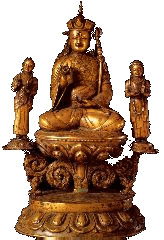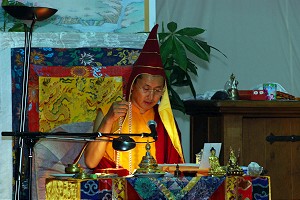The Pinnacle of the Nine Gradual Vehicles
The Nyingma (Early Translation tradition) of Tibetan Buddhism classifies the Buddhist teachings in a progression of nine successive vehicles.

-
three outer vehicles leading from the origin [of suffering] —related to the three piṭakas of characteristics: the Śrāvaka Vehicle, the Pratyekabuddha Vehicle, and the Bodhisattva Vehicle.
-
three inner vehicles of Vedic-like asceticism —the three outer classes of tantra: the Vehicles of the Kriyā Tantra, Caryā Tantra, Yoga Tantra.
-
three secret vehicles of powerful transformative methods —the three inner classes of tantra: the Mahāyoga, Anuyoga, and Atiyoga or Dzogchen in Tibetan.
Dzogpachenpo . རྫོགས་པ་ཆེན་པོ་, in short Dzogchen, means the ‘Great Perfection’, or ‘Great Completeness’. The practice of Dzogchen is the most ancient and direct stream of wisdom within the Buddhist tradition of Tibet. It is a way in which we can realize the innermost nature of mind—that which we really are—which is the clearest, most effective, and most relevant to the modern world.
Dzogchen Monastery in Tibet
Dzogchen Monastery is one of the Six Great Seats of the Nyingma school, the Old Translation school, of Tibetan Buddhism.
It was founded in 1685 by HE Dzogchen Pema Rinzin (the first Dzogchen Rinpoche) who was the most outstanding Dzogchen master of his time and meditation teacher to His Holiness the Great Fifth Dalai Lama. Having received all the Dzogchen teachings, His Holiness instructed Pema Rinzin to travel to the Kham region of Eastern Tibet and found a monastery, so that the teachings might prosper.
After the establishment of the monastery the area become know as "Dzogchen".
The Dzogchen Monastery includes:
-
a monastery
-
a universtity
-
a retreat center
-
several retreta caves
After the cultural revolution, the reconstruction of the monastery started in the 1980.
- More recently many new temples, a stupa, and much more were build.
www.dzogchen-monastery.org
Youtube channel (with more recent content)


|
